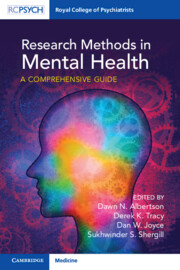Book contents
- Research Methods in Mental Health
- Reviews
- Research Methods in Mental Health
- Copyright page
- Contents
- Contributors
- Foreword
- Foreword
- Section 1 Principles of Research
- Chapter 1 The Foundations
- Chapter 2 Principles of Open Science
- Chapter 3 Writing Up Research
- Chapter 4 Equity, Diversity, and Inclusion in Academic Careers and Research
- Chapter 5 Changing Times – Patient and Public Involvement in Research
- Section 2 Tools and Methodologies
- Section 3 Contemporary Applications
- Index
- References
Chapter 5 - Changing Times – Patient and Public Involvement in Research
from Section 1 - Principles of Research
Published online by Cambridge University Press: 31 October 2025
- Research Methods in Mental Health
- Reviews
- Research Methods in Mental Health
- Copyright page
- Contents
- Contributors
- Foreword
- Foreword
- Section 1 Principles of Research
- Chapter 1 The Foundations
- Chapter 2 Principles of Open Science
- Chapter 3 Writing Up Research
- Chapter 4 Equity, Diversity, and Inclusion in Academic Careers and Research
- Chapter 5 Changing Times – Patient and Public Involvement in Research
- Section 2 Tools and Methodologies
- Section 3 Contemporary Applications
- Index
- References
Summary
This chapter has been written from the stance of a patient and public contributor to mental health research. It examines the role of patient and public involvement in mental health research which has evolved since the mid 1960s and continues to do so. Examining the people, roles and research and providing a definition for the different stages of Patient and Public Involvement, the chapter looks at how these roles interact, the ethics and rationale for involvement, the power relations between the various parties, whether involvement is moving the research agenda closer to preventative health care, and the subject of equality, diversity and inclusion. The difficulties of working with people with serious mental health issues are addressed. Case studies are given to illustrate various points. Subjects such as training and language are included. The complex subject of evaluation and impact and how they can be resolved are raised. Finally, the chapter concludes by inviting the reader to consider what ‘good PPI’ is, and how it is done.
Keywords
Information
- Type
- Chapter
- Information
- Research Methods in Mental HealthA Comprehensive Guide, pp. 65 - 80Publisher: Cambridge University PressPrint publication year: 2025
References
Accessibility standard: WCAG 2.0 A
Why this information is here
This section outlines the accessibility features of this content - including support for screen readers, full keyboard navigation and high-contrast display options. This may not be relevant for you.Accessibility Information
Content Navigation
Allows you to navigate directly to chapters, sections, or non‐text items through a linked table of contents, reducing the need for extensive scrolling.
Provides an interactive index, letting you go straight to where a term or subject appears in the text without manual searching.
Reading Order & Textual Equivalents
You will encounter all content (including footnotes, captions, etc.) in a clear, sequential flow, making it easier to follow with assistive tools like screen readers.
You get concise descriptions (for images, charts, or media clips), ensuring you do not miss crucial information when visual or audio elements are not accessible.
Visual Accessibility
You will still understand key ideas or prompts without relying solely on colour, which is especially helpful if you have colour vision deficiencies.
Structural and Technical Features
You gain clarity from ARIA (Accessible Rich Internet Applications) roles and attributes, as they help assistive technologies interpret how each part of the content functions.
